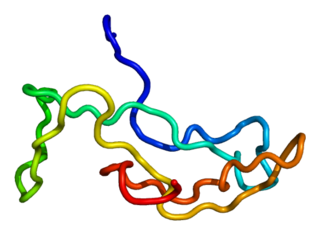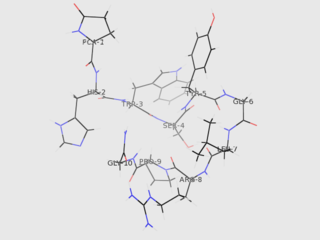Follitropin subunit beta also known as follicle-stimulating hormone beta subunit (FSH-B) is a protein that in humans is encoded by the FSHB gene. [5] [6] [7] Alternative splicing results in two transcript variants encoding the same protein.
Follitropin subunit beta also known as follicle-stimulating hormone beta subunit (FSH-B) is a protein that in humans is encoded by the FSHB gene. [5] [6] [7] Alternative splicing results in two transcript variants encoding the same protein.
The pituitary glycoprotein hormone family includes follicle-stimulating hormone, luteinizing hormone, chorionic gonadotropin, and thyroid-stimulating hormone. All of these glycoproteins consist of an identical alpha subunit and a hormone-specific beta subunit. This gene encodes the beta subunit of follicle-stimulating hormone. In conjunction with luteinizing hormone, follicle-stimulating hormone induces egg and sperm production. [7]
The FSHB gene in human DNA encodes the follicle-stimulating hormone subunit beta protein (FSH-B), or Follitropin Beta. More specifically, the FSHB gene encodes for the beta subunit of follicle-stimulating hormone (FSH). Therefore, proper transcription of FSHB allows for the proper production of FSH. FSH is a peptide hormone the pituitary gland produces that is involved with the reproductive system. FSH promotes follicular oocyte (egg) production, growth, and maturation and helps control a female's menstrual cycle. Additionally, FSH is involved in the male reproductive system by stimulating spermatogenesis (maturation of sperm cells) and initiating puberty. Studies show that variations in the FSHB gene can contribute to the likelihood of a woman becoming pregnant with fraternal, or dizygotic, twins. [8] This is because certain heritable variations of FSHB contribute to increased production of FSH from the pituitary gland, raising the levels of FSH found in a woman’s blood. It is also shown that women with these FSHB variants had their first menstrual cycle, children, and menopause at an earlier age than women without the variant. [8] This relates to having an increased risk of a woman bearing fraternal twins because higher levels of FSH will produce more eggs. [9] The more eggs a woman produces increases the chance of multiple eggs ovulating and becoming fertilized by sperm. In retrospect, depending on the type of variation, the FSHB gene could potentially cause infertility by the inability to produce enough FSH, in both males and females. [8] [10] [11] Additionally, low or no FSH can result in delayed puberty and risk of disease. [12] [13] Diseases associated with FSHB variants are hypogonadism, hypogonadotropic hypogonadism type 24 (HH24), and type 7 (HH7), and are possibly linked to polycystic ovary syndrome. [12] [13] [14]

Luteinizing hormone is a hormone produced by gonadotropic cells in the anterior pituitary gland. The production of LH is regulated by gonadotropin-releasing hormone (GnRH) from the hypothalamus. In females, an acute rise of LH known as an LH surge, triggers ovulation and development of the corpus luteum. In males, where LH had also been called interstitial cell–stimulating hormone (ICSH), it stimulates Leydig cell production of testosterone. It acts synergistically with follicle-stimulating hormone (FSH).

Follicle-stimulating hormone (FSH) is a gonadotropin, a glycoprotein polypeptide hormone. FSH is synthesized and secreted by the gonadotropic cells of the anterior pituitary gland and regulates the development, growth, pubertal maturation, and reproductive processes of the body. FSH and luteinizing hormone (LH) work together in the reproductive system.

Gonadotropin-releasing hormone (GnRH) is a releasing hormone responsible for the release of follicle-stimulating hormone (FSH) and luteinizing hormone (LH) from the anterior pituitary. GnRH is a tropic peptide hormone synthesized and released from GnRH neurons within the hypothalamus. The peptide belongs to gonadotropin-releasing hormone family. It constitutes the initial step in the hypothalamic–pituitary–gonadal axis.
Gonadotropins are glycoprotein hormones secreted by gonadotropic cells of the anterior pituitary of vertebrates. This family includes the mammalian hormones follicle-stimulating hormone (FSH) and luteinizing hormone (LH), the placental/chorionic gonadotropins, human chorionic gonadotropin (hCG) and equine chorionic gonadotropin (eCG), as well as at least two forms of fish gonadotropins. These hormones are central to the complex endocrine system that regulates normal growth, sexual development, and reproductive function. LH and FSH are secreted by the anterior pituitary gland, while hCG and eCG are secreted by the placenta in pregnant humans and mares, respectively. The gonadotropins act on the gonads, controlling gamete and sex hormone production.

The hypothalamic–pituitary–gonadal axis refers to the hypothalamus, pituitary gland, and gonadal glands as if these individual endocrine glands were a single entity. Because these glands often act in concert, physiologists and endocrinologists find it convenient and descriptive to speak of them as a single system.
Isolated hypogonadotropic hypogonadism (IHH), also called idiopathic or congenital hypogonadotropic hypogonadism (CHH), as well as isolated or congenital gonadotropin-releasing hormone deficiency (IGD), is a condition which results in a small subset of cases of hypogonadotropic hypogonadism (HH) due to deficiency in or insensitivity to gonadotropin-releasing hormone (GnRH) where the function and anatomy of the anterior pituitary is otherwise normal and secondary causes of HH are not present.
The gonadotropin-releasing hormone receptor (GnRHR), also known as the luteinizing hormone releasing hormone receptor (LHRHR), is a member of the seven-transmembrane, G-protein coupled receptor (GPCR) family. It is the receptor of gonadotropin-releasing hormone (GnRH). The GnRHR is expressed on the surface of pituitary gonadotrope cells as well as lymphocytes, breast, ovary, and prostate.

The gastric inhibitory polypeptide receptor (GIP-R), also known as the glucose-dependent insulinotropic polypeptide receptor, is a protein that in humans is encoded by the GIPR gene.

Gonadotropin-releasing hormone receptor is a protein that in humans is encoded by the GNRHR gene.

Inhibin, beta A, also known as INHBA, is a protein which in humans is encoded by the INHBA gene. INHBA is a subunit of both activin and inhibin, two closely related glycoproteins with opposing biological effects.

Inhibin, alpha, also known as INHA, is a protein which in humans is encoded by the INHA gene.

Glycoprotein hormones, alpha polypeptide is a protein that in humans is encoded by the CGA gene.

Homeobox protein prophet of PIT-1 is a protein that in humans is encoded by the PROP1 gene.

LIM/homeobox protein Lhx3 is a protein that in humans is encoded by the LHX3 gene.

Choriogonadotropin subunit beta variant 1 is a protein that in humans is encoded by the CGB1 gene.

Inhibin, beta B, also known as INHBB, is a protein which in humans is encoded by the INHBB gene. INHBB is a subunit of both activin and inhibin, two closely related glycoproteins with opposing biological effects.

Luteinizing hormone subunit beta also known as lutropin subunit beta or LHβ is a polypeptide that in association with an alpha subunit common to all gonadotropin hormones forms the reproductive signaling molecule luteinizing hormone. In humans it is encoded by the LHB gene.

Thyroid stimulating hormone, beta also known as TSHB is a protein which in humans is encoded by the TSHB gene.
Gonadotropin preparations are drugs that mimic the physiological effects of gonadotropins, used therapeutically mainly as fertility medication for ovarian hyperstimulation and ovulation induction. For example, the so-called menotropins consist of LH and FSH extracted from human urine from menopausal women. There are also recombinant variants.

The fertile eunuch syndrome or Pasqualini syndrome is a cause of hypogonadotropic hypogonadism caused by a luteinizing hormone deficiency. It is characterized by hypogonadism with spermatogenesis. Pasqualini and Bur published the first case of eunuchoidism with preserved spermatogenesis in 1950 in la Revista de la Asociación Médica Argentina. The hypoandrogenism with spermatogenesis syndrome included:
{{cite journal}}: CS1 maint: overridden setting (link){{cite journal}}: CS1 maint: overridden setting (link){{cite journal}}: CS1 maint: overridden setting (link){{cite journal}}: CS1 maint: overridden setting (link){{cite journal}}: CS1 maint: overridden setting (link){{cite journal}}: CS1 maint: overridden setting (link){{cite journal}}: CS1 maint: overridden setting (link){{cite journal}}: CS1 maint: overridden setting (link){{cite journal}}: CS1 maint: overridden setting (link)